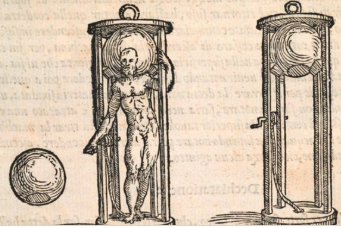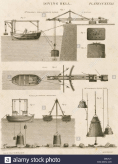In part 2 we deal with the years 1535 – 1790.
(A good source in creating this chronology has been SPUMS Journal Volume 29 No.2 June 1999. Spums Archive
If you have the rights to any of the images used to illustrate the material, please contact us through our contact form and we will give you credit for the image, or remove it if you wish.)
1535 Guglielmo de Lorena and Francesco de Marchi


Two different descriptions of the equipment.
The earliest use of a kind of breathing apparatus and the first underwater archaeological survey took place in July 1535, when Guglielmo de Lorena and Francesco de Marchi explored two Roman barges lowered in the crater lake Nemi about 30 kilometers from Rome using a one-person diving bell such as Guglielmo had invented. The two barges had served as platforms for a floating palace built for Emperor Caligula during the first century AD. The palace itself was long gone.
Francesco’s book on military architecture contains first-hand documentation of the exploration and of the diving bell; however, the author refrained from describing the bells’ most exciting feature, the air supply mechanism. The diving bell was very small, more like a big diver’s helmet, the air it contained could only last for a diver for a few minutes. However, it had a mechanism that expelled breathing air while maintaining sufficient air pressure inside to prevent the water level from rising and this mechanism allowed the diver to work submerged for hours. Francesco did not describe this mechanism because he had sworn to keep Guglielmo’s invention secret.
The diving bell is described as a round barrel made of oak plank, about 4.5 centimeters thick. It was about 1.25 meters long and about 75 centimeters in diameter. Around the open part was a lead ring, more than two inches thick and six hooks of iron. A thick crystal piece, a palm long, and a half palm wide were mounted at eye level. The diver carried the barrel with the help of a pair of braces that were attached to the barrel’s inner walls. A branch strap, with a simple maneuverable lock, also attached to the inner wall, kept the bell attached to the diver.
The diving bell barely reached down to half the upper arms in the water and thus allowed the arms to be used for work. On land, the barrel was too heavy for a man to carry. In the water, it weighed around 40 kilos.
Each barge was approximately 70 m long and 20 m wide at the beam. The description shows that a typical dive lasted from one to two hours at a diving depth varying from 10 to 20 meters. According to the description, cold and fatigue were the limiting factors for longer diving time, not lack of air. The divers refrained from going down under the deck for fear of falling, which would have inexorably emptied the diver’s bell of air.
Francesco describes diving with the bell as follows. ”From the elbows and upwards, you were warm, but underneath you were cold”.
From the description of the bell it is stated that the diving bell, with a diver in it, should have contained about four hundred liters of air and with that, you can not manage many minutes under the surface. The exhaled air must be vented away and fresh air must enter. How do you manage it without a pump? Francesco does not reveal it, so it may be speculation. Exhaling air is the easiest to solve. The air that exhales is significantly warmer than the ambient air in the diving bell. It will thus rise and gather at the top of the bell. With a valve, probably manually controlled, it is possible to release it at regular intervals. The problem remains that a reduced air content in the diving bell causes the water level inside it to rise and risk drowning the diver and that the diver must get fresh air. In other words, air must be supplied. This can be done using barrels fitted with tubes that are plugged. When the barrel reaches the diving bell, the pipe part is inserted into the bell and the plug is removed, whereby the fresh air flows into the bell. (This is the solution of the referenced text. This chronology author’s solution is to use waterproof cloth bags instead, which could be obtained by, for example, tarring the fabric. When the plug is removed, the surrounding water pressure will compress the bag and the air is forced out. A waterproof bag thus means both a safer and more efficient discharge.) If this theory is true, it is the same principle ascribed to Halley 150 years 11.
1616 Franz Kessler

Franz Kessler, a portrait painter, researcher, inventor and alchemist designs and develops a diving bell12.
1620 Cornelius Drebbel

Cornelius Drebbel was a Dutch inventor and naturalist who lived a large part of his life in London. Drebbel was the first to design a submarine that was also built and tested. The submarine was propelled with the help of six pairs of oars and tested in the Thames at a depth of about five meters. There is different information on the air supply. Some believe that the submarine had a kind of snorkel with buoys at the surface, others believe that Drebbel created oxygen by heating sulfur and potassium nitrate. Inside the submarine, atmospheric pressure prevailed13.
1640 Von Treileben

The Swedish warship Vasa capsized and sank off Beckholmen in Stockholm’s inlet on its maiden voyage, August 10, 1628. The wreck was lying at a depth of 32 meters. Several salvage attempts were made, but none succeeded and the wreckage was forgotten for a time. In 1658, the Swede von Treileben received a privilege for diving along the Swedish coast together with his diving group of just under 20 people. The group operated from Gothenburg and specialized in salvaging cannons. In 1663, the Swede Treileben was granted the right to recover Vasa and he formed a company together with the German Peckel who believed that he had made an invention with which the whole wreck could be lifted. However, it failed and Treileben broke with Peckel to take his own diving group from Gothenburg in the spring of 1664. They immediately salvaged 4 bronze cannons from the wreck and Treileben, who had now completely abandoned the idea of salvaging the entire ship, concentrated on the cannons. More than 50 of the 64 cannons were salvaged, which can be considered a great success. Treileben also designed a diving watch to facilitate diving at Vasa14.
The Italian priest Francesco Negri undertook a trip to the Northern Cape in 1663-65, in itself an adventure at that time. Negri was in Stockholm in the autumn of 1663, where he became an eyewitness to the diving that was then undertaken at Vasa. We let him tell us about the divers’ upholstery and dressing. They called out whoever was going down to the bottom of the sea. He sat down and an iron ring was carried to him, in which he could stick a foot and a leg, he let it go all the way up over the knee, then he put on a leather boot up over the iron ring, two other men tied it tightly around him with a long rope, several turns, for the iron ring was about two fingers wide. the second ring was placed and the boot on the other leg in the same way, then they gave him the third ring which was larger than the first. This was set over the head, shoulders and arms all the way to the waist. Then, over the other suit, a pair of trousers, also of thick leather and finally a similar jacket, were pulled on, and they tied them all tightly at the rings at the waist and at the thighs. There was something left to his head, he took nothing but a plain cloth cover, and he didn’t even lower it all the way to his neck, leaving it as high as a regular cap. ”
Negri then goes on to describe the dive bell itself.
“On this raft was a bell of lead, five hands high and wide in proportion thereto, which with a long rope fixed, at the upper part, could be pulled up by some men, by means of a waist, carried by two board pieces. When the bell had been raised to little more than half the man’s length, he then went into it and ascended a plate of lead which was firmly bound and hung in the bell instead of the clapper. Near the estuary; there are four small holes in this bell, through which four ropes pass, and well-connected at the top they run down to hold up this lead plate, and in this way pass through its four corners and should be two hands lower than this one. The man got a round wooden stick in his hand barely thicker than a pike and two or three cubits long. At the top of which is attached an iron hook, so that he can grasp the things he discovers; Then the clock was pushed out on the water and allowed to sink with the man, who goes all the way to the bottom, who at this place has 16 men depth according to what I found, when I measured it with a rope, although it would be much deeper the result would be the same . When I had seen this and understood the reason why the man could remain there underwater for up to half an hour”15.
1662 Nathaniel Henshaw

The world’s first pressure chamber was constructed by the English priest Nathaniel Henshaw. He used a system of organ bellows with unidirectional valves to change the atmospheric pressure in a sealed chamber called ”Domicilium”. Henshaw argued, without any scientific justification, that high air pressure would relieve emergency conditions while lower pressures would help with chronic disorders. He believed that Domicilium therapy would improve digestion and prevent lung diseases by managing environmental pressures. Oxygen concentration was not mentioned for obvious reasons, as oxygen was not discovered until almost a hundred years later. The chamber was never used as far as is known to cure diving-related injuries, however, Edmond Halley used the principle to provide his diving bell with fresh air16.
(Editor’s note Given that the pressure rise is accomplished with bellows, the pressure in the ”Domicilium” is likely to be no more than a meter of water column. )
As a curiosity it can be mentioned that in the 1990s a company started in Edinbridge that manufactures pressure chambers. The company is called Henshaw. However, it has no connection to the 16th century pioneer.)
1680 Borelli

Italian mathematician Borelli constructs the world’s first rebreather. The exhaled air goes to a couple of copper pipes where the air is considered to be purified by cooling the pipes by the surrounding sea water. The brass helmet had a diameter of 60 cm and was equipped with a window. A piston device was used to create buoyancy. The diver is illustrated with claw-like fins, which is considered to indicate that the diver would be free-swimming. To the best of our knowledge, the equipment was never tested17.
1691 Edmond Halley

Edmond Halley (Halley’s Comet) builds a diving bell. The air quality in the bell was improved with the help of weighted barrels sent down from the surface. By adding air, the ”water surface” could also be maintained at the bottom of the bell, even though the air was compressed during the immersion in the water.
At a demonstration, Halley and five companions dived to 18 meters in the Thames and stayed at that depth for more than an hour and a half. Halley’s bell was of little use for practical diving work as it was very heavy. However, improvements were made over time and Halley extended its exposure time underwater to over four hours18.
1715 John Lethbridge

John Lethbridge was a wool merchant from Newton Abbot. He invented a diving machine in 1715. After testing the machine in his garden pond (specially built for the purpose), Lethbridge appeared on a number of wrecks and became relatively wealthy. The machine was an airtight oak barrel that allowed the diver to stay under the surface long enough to retrieve underwater material.
Description of the machine with Lethbridge’s own words. “It is board-wide and perfectly round, about 2 meters in length, about 60 centimeters at the head and about 46 centimeters in diameter at the foot and contains about 136 liters of air; it is assembled with iron bands both on the outside and inside to protect against pressure. There are two holes for the arms, and a glass with a diameter of about 10 centimeters and 32 millimeters thick to look through, which is fixed in the lower part, so that it is in a direct line with the eye, two air holes in the upper part , in which an air is transported by a pair of bellows, both of which are stopped by plugs immediately before it goes down to the bottom. At the base there is a hole to let water out. Sometimes there is a large rope fixed to the back or the upper part through which it is dropped, and there is a thin line called the signal line, through which the people above are directed what to do, and underneath is a piece of wood attached to protect it. glass. I get in with my feet first and when my arms go through the holes, the lid is put on, which is fastened with screws. It requires 227 kilos of weight to lower it and if you remove 7 kilos of weight it will begin to rise to the surface. I lie straight on my chest all the time I am in it, which has often been more than 6 hours, the air is often updated from the surface by a pair of bellows. I can move it about 1 square meter on the bottom, where I have stayed many times 34 minutes. I have been at 18 meters many hundreds of times and have been at 22 meters but with great difficulties 19.
(Edited note. Already at 1.5 meters depth, blood circulation in the arms stops because the blood pressure is not enough to express blood to the arms which are at higher pressure outside the barrel.)
1741 Mårten Triewald

Swedish inventor Mårten Triewald publishes the book ”The art of living under water”. The book describes, among other things, diving bells, which Triewald also designed and built. The book was considered groundbreaking for its time. Triewald took the initiative to form the Northern Recovery Company, which in 1734 gained a royal monopoly on salvaging vessels in Swedish water.
Triewald also built Sweden’s first steam engine in 1726, partly with parts he brought home from England, as well as Sweden’s first air conditioning, a kind of ”weather exchange machine” that would improve the air under deck on ships.
During his years in England in 1731, Triewald was elected a member of the Royal Society, the world’s oldest and most prestigious scientific association. In 1739, Triewald together with his friend Carl von Linne and with the strong support of Jonas Alströmer took the initiative to establish the Royal Swedish Academy of Sciences, where he was also a diligent employee 20, 21, 22.
(Editor’s note. A large part of the scientific instruments that Triewald brought home from England were donated to Lund University in connection with the establishment of a professorship. Some of these instruments are currently on display at the Malmö Museum.
It is not improbable that Triewald met Halley during his stay in England where he was, among other things, building Newcomen steam machines at mines in Newcastle.)
1790 John Smeaton


John Smeaton, perhaps best known as the father of civil engineering, and for the construction of several waterproof buildings, also built what may be called the first modern diving bell. It is a reconstruction of the bell he built in 1788. However, the older of the bells was not intended to be lowered below the water surface. both bells were equipped with steam-powered pumps that pushed air into the diving bells23.
References
Please note that many of the references are to Swedish pages or books.
11. Guglielmo de Lorena, Francesco de Marchi. Besökt 20200425.
.12. Franz KesslerBesökt 20200425.
13. Cornelis Drebbel. Besökt 20200520.
14. Signallinan nr. 20. Besökt 20200429
15. Casell Bo, Havet Dykaren Fynden under 2000 år, P.A. Norstedt & Söners Förlag. 1967. ISBN saknas.
16. Jain KK. The History of Hyperbaric Medicine. In Textbook of Hyperbaric Medicine. 2nd edition. Jain KK. Ed. Seattle: Hogrefe and Huber, 1996.
17.Davis RH. Deep diving and submarine operations 7th edition. London: St Catherine Press, 1962; 7-9
18. Edmond Halley.Besökt 20200425.
19. John Lettbridge. Besökt 20200429
20. Triewald. Besökt 20200429
21. Triewald. Besökt 20200429
22. Triewald. Besökt 20200429
23. John Smeaton. Besökt 20200426
